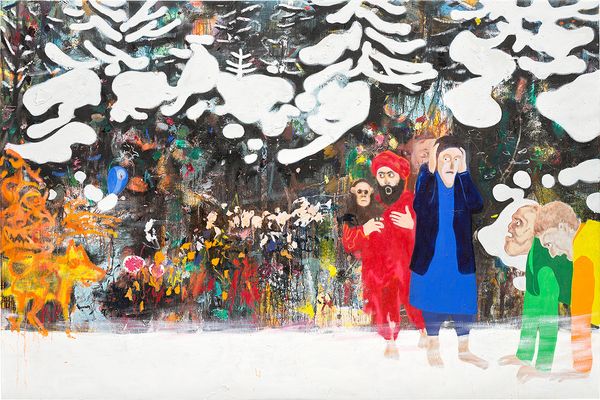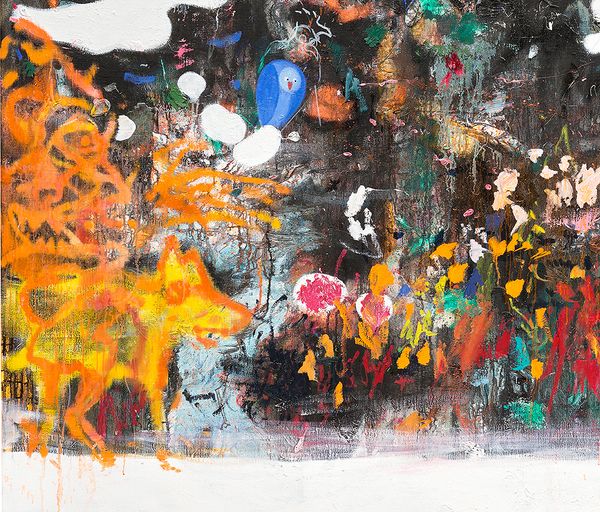Daniel Richter, Schakal Reloaded, 2009. 20th Century & Contemporary Art.
In the divided Germany of the 1980s, a group of outcasts in Hamburg emerged as a creative community united by a shared belief in a socialist future and a disdain for leadership in both the East and West. “In the early ‘80s, late ‘70s when I was young, punk was the way out,” painter Daniel Richter once recalled of his youth. Richter joined this informal group in his early 20s, squatting in abandoned buildings and engaging with the city’s thriving punk scene. The artist spent a decade living in this Hamburg community, satisfying his creative urge by making punk concert posters. He preferred to work alone, not favoring the inherently collaborative nature of music-making, later noting that making imagery “was the natural role the subculture chose for me.”
The artist has recounted that this period was not without conflict, as the group often faced public backlash and assaults from the police, as well as violence from neo-Nazi groups. These early encounters added steam to Richter’s already established skepticism of authority, which can be seen throughout his later work.
“The idea was not to wait for the communist party, but instead to do it ourselves.”
—Daniel Richter
When the Berlin Wall fell, Richter’s reality crumbled, and the unification of Germany prompted the painter’s creative expansion into fine art. He remembers that when “the Soviet Union collapsed it was clear to me that there would be shifts of power in the world and that the idea of what a democracy is will be massively changing.” It was at this point, at the age of 30, that the artist realized he needed to find a new path, as many in his orbit had either become bitter with age or died young. It was a struggle for him to make this leap, recalling, “I didn’t have money, I didn’t have wealthy parents, I didn’t have any education, so I was a bum by definition of the State. The only thing that I had always done, and I’d always been obsessed with, was images.”
He enrolled at the Hochschule für bildende Künste in Hamburg to discover what can define art, led by a questioning of the artistic validity of his own posters. Upon graduation he worked as assistant to several artists, most notably Albert Oehlen, as he refined his painterly style, initially emerging on the scene with colorful abstract paintings before shifting to the more figurative and politically charged paintings that are emblematic of his social outlook.
A Symbolic Jackal
Daniel Richter, Schakal Reloaded, 2009. 20th Century & Contemporary Art.
Richter’s 2009 work Schakal Reloaded is a striking canvas that reflects the fraught political landscape of the early 2000s and the horrors of the war on terror. In this painting we’re confronted with what at first seems to be an enchanted mountain landscape, the complex narrative concentrated in Richter’s flattened pictorial space. This graphic visual language coupled with the work’s expressive use of color are somewhat reminiscent of graffiti and street art, perhaps relating to the artist’s early experience. On closer look, we discover a jackal figure at the left of the composition, rendered in a hazy orange. Its presence is menacing, and the nearby human figures scream in terror. It is the turbans of these figures coupled with Richter’s visual suggestion of the jackal’s symbolic associations that call to mind the charged political atmosphere of the time, reminding us of the nickname given to the powerful armored vehicles deployed to the Middle East by the United Kingdom. The overtones of the associations in this image can be considered as ascribed to the Western militaries, assigning them the personality of a cunning trickster, indifferent to the plight of others. Poignantly, we realize this scene places us in the mountainous border region between Afghanistan and Pakistan, where the “jackal” vehicle roamed.
Daniel Richter, Schakal Reloaded (detail), 2009. 20th Century & Contemporary Art.
This work is deeply rooted in the events that have defined Richter’s creative life. If the German reunification was the first historical event that shook Richter’s world, the terrorist attacks of September 11th were the second. The two are linked for Richter, as he has noted, “The fall of the Wall and the crumbling of the Soviet Union are the reason for the reappearance of religions and nationalism haunting us today.” By suggesting through charged symbolism that Western militaries are untrustworthy, Schakal Reloaded presents us with the tragic absurdity of such political tensions. The artist has made countless pointed comments on this dynamic in the post-9/11 era. He has remarked of Islamic extremism that “it’s a war for dumb guys believing in lord penis, in guns and violence, and all that kind of paranoid, fascist, megalomanic power scheisse.” In turn, he’s also pointed out that the very same ideals flow through the male leadership of some recent Western administrations and has questioned how the war machine has allowed Western economies to flourish. These ideas represent what perhaps defines Daniel Richter’s thinking — a continuous challenge of authority demonstrated not just by an approach to art and imagery, but to a way of life.
Discover More from 20th Century & Contemporary Art >
Recommended Reading
Unreliable Witness: On memory and veracity in ‘Rome’ by Luc Tuymans >


